Critical Reflection on Active Listening in Social Work Practice
VerifiedAdded on 2022/09/12
|5
|1218
|19
Practical Assignment
AI Summary
This assignment is a critical self-reflection on the student's demonstration of active listening skills in a social work context, based on a video recording of a role-play scenario. The reflection addresses the importance of active listening in client engagement, identifying strengths of the demonstration, such as creating a conducive environment for communication and problem-solving, and recognizing non-verbal cues. It also explores areas for improvement, including using more explicit verbal cues and minimizing distractions. The student outlines a plan to enhance their practice by focusing on self-awareness, summarizing key points during conversations, developing empathy, and practicing regularly to improve their communication skills and build stronger relationships with clients. The assignment aims to demonstrate the student's understanding of active listening and its practical application in social work practice, in line with the assignment brief's requirements for critical analysis and self-assessment.
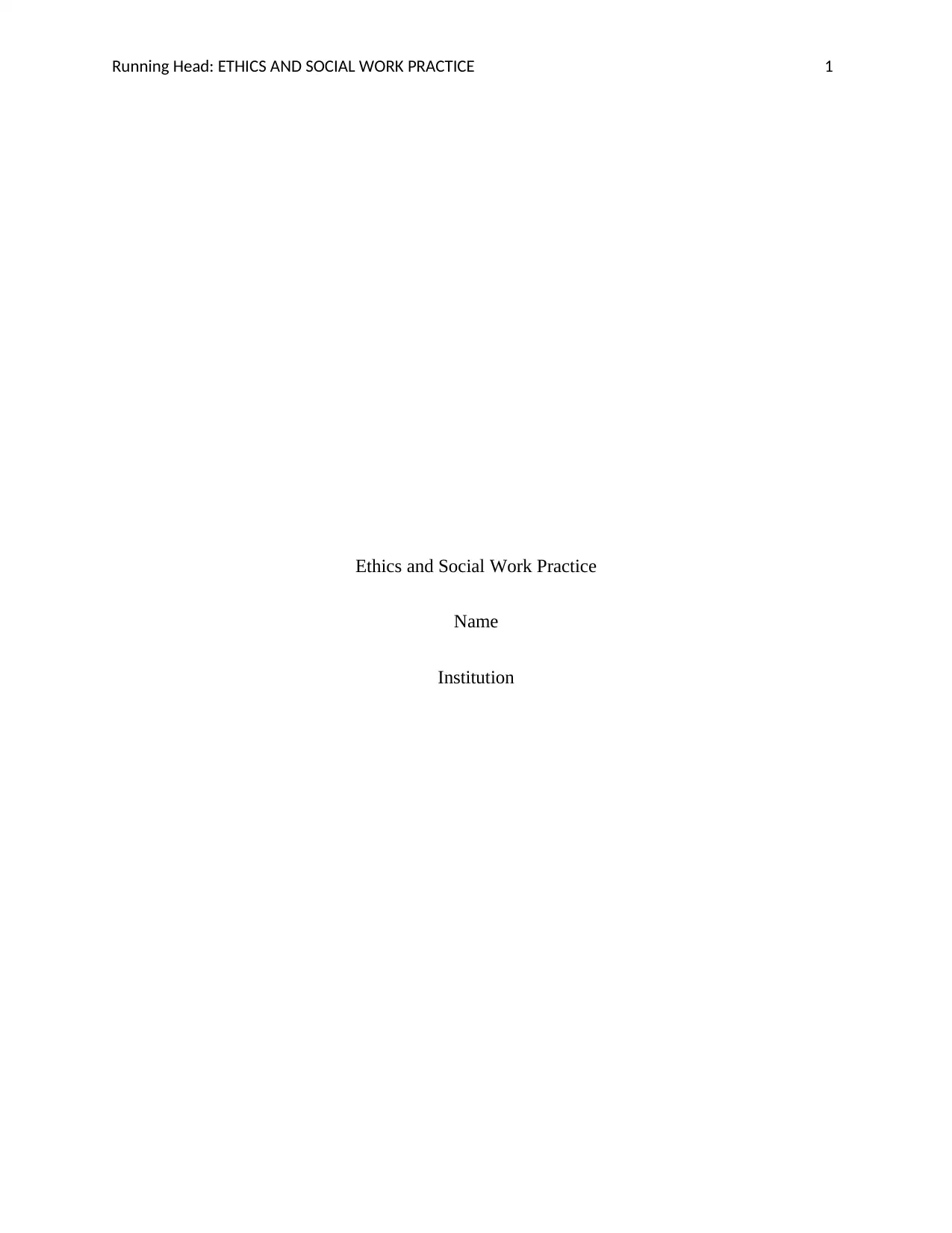
Running Head: ETHICS AND SOCIAL WORK PRACTICE 1
Ethics and Social Work Practice
Name
Institution
Ethics and Social Work Practice
Name
Institution
Paraphrase This Document
Need a fresh take? Get an instant paraphrase of this document with our AI Paraphraser
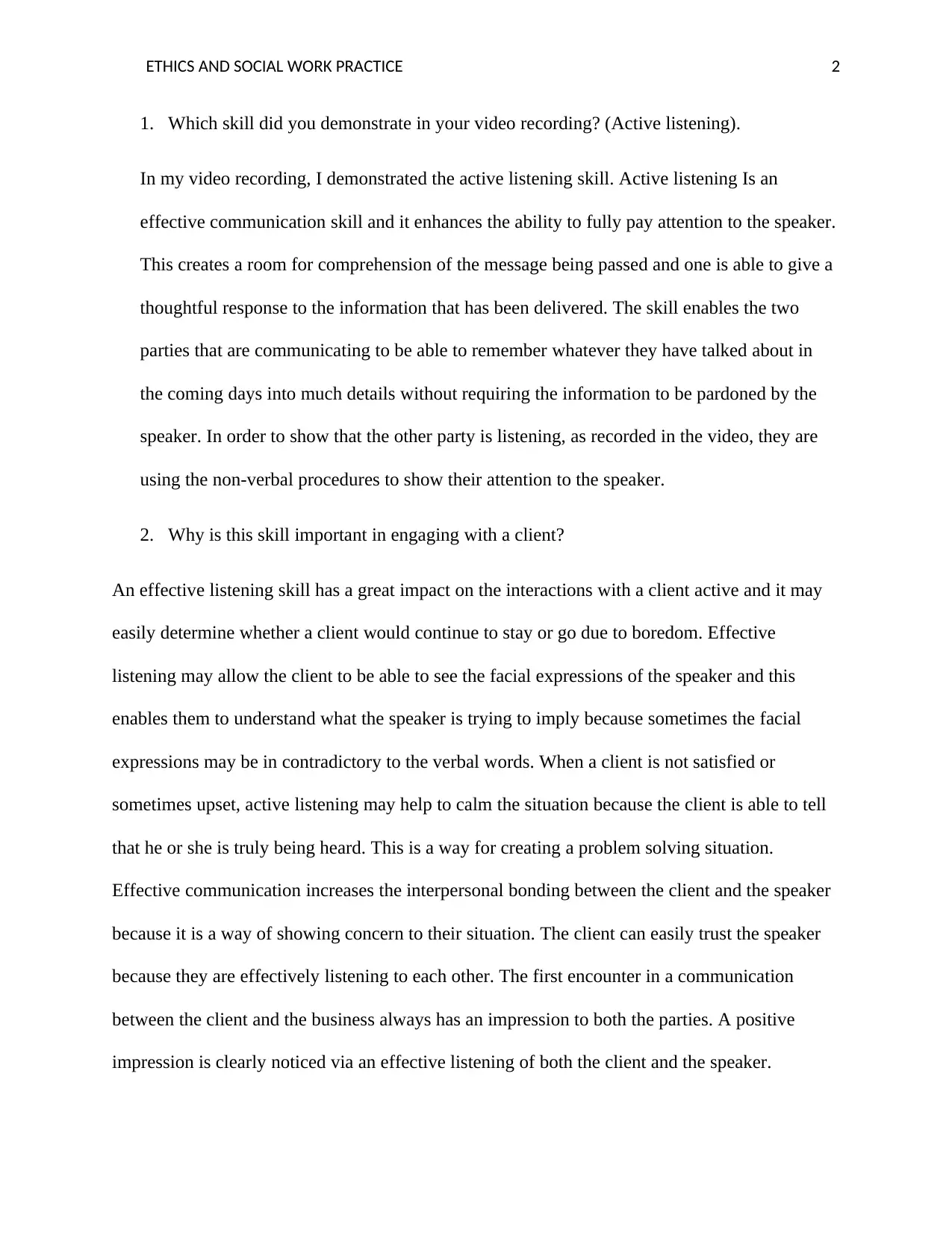
ETHICS AND SOCIAL WORK PRACTICE 2
1. Which skill did you demonstrate in your video recording? (Active listening).
In my video recording, I demonstrated the active listening skill. Active listening Is an
effective communication skill and it enhances the ability to fully pay attention to the speaker.
This creates a room for comprehension of the message being passed and one is able to give a
thoughtful response to the information that has been delivered. The skill enables the two
parties that are communicating to be able to remember whatever they have talked about in
the coming days into much details without requiring the information to be pardoned by the
speaker. In order to show that the other party is listening, as recorded in the video, they are
using the non-verbal procedures to show their attention to the speaker.
2. Why is this skill important in engaging with a client?
An effective listening skill has a great impact on the interactions with a client active and it may
easily determine whether a client would continue to stay or go due to boredom. Effective
listening may allow the client to be able to see the facial expressions of the speaker and this
enables them to understand what the speaker is trying to imply because sometimes the facial
expressions may be in contradictory to the verbal words. When a client is not satisfied or
sometimes upset, active listening may help to calm the situation because the client is able to tell
that he or she is truly being heard. This is a way for creating a problem solving situation.
Effective communication increases the interpersonal bonding between the client and the speaker
because it is a way of showing concern to their situation. The client can easily trust the speaker
because they are effectively listening to each other. The first encounter in a communication
between the client and the business always has an impression to both the parties. A positive
impression is clearly noticed via an effective listening of both the client and the speaker.
1. Which skill did you demonstrate in your video recording? (Active listening).
In my video recording, I demonstrated the active listening skill. Active listening Is an
effective communication skill and it enhances the ability to fully pay attention to the speaker.
This creates a room for comprehension of the message being passed and one is able to give a
thoughtful response to the information that has been delivered. The skill enables the two
parties that are communicating to be able to remember whatever they have talked about in
the coming days into much details without requiring the information to be pardoned by the
speaker. In order to show that the other party is listening, as recorded in the video, they are
using the non-verbal procedures to show their attention to the speaker.
2. Why is this skill important in engaging with a client?
An effective listening skill has a great impact on the interactions with a client active and it may
easily determine whether a client would continue to stay or go due to boredom. Effective
listening may allow the client to be able to see the facial expressions of the speaker and this
enables them to understand what the speaker is trying to imply because sometimes the facial
expressions may be in contradictory to the verbal words. When a client is not satisfied or
sometimes upset, active listening may help to calm the situation because the client is able to tell
that he or she is truly being heard. This is a way for creating a problem solving situation.
Effective communication increases the interpersonal bonding between the client and the speaker
because it is a way of showing concern to their situation. The client can easily trust the speaker
because they are effectively listening to each other. The first encounter in a communication
between the client and the business always has an impression to both the parties. A positive
impression is clearly noticed via an effective listening of both the client and the speaker.
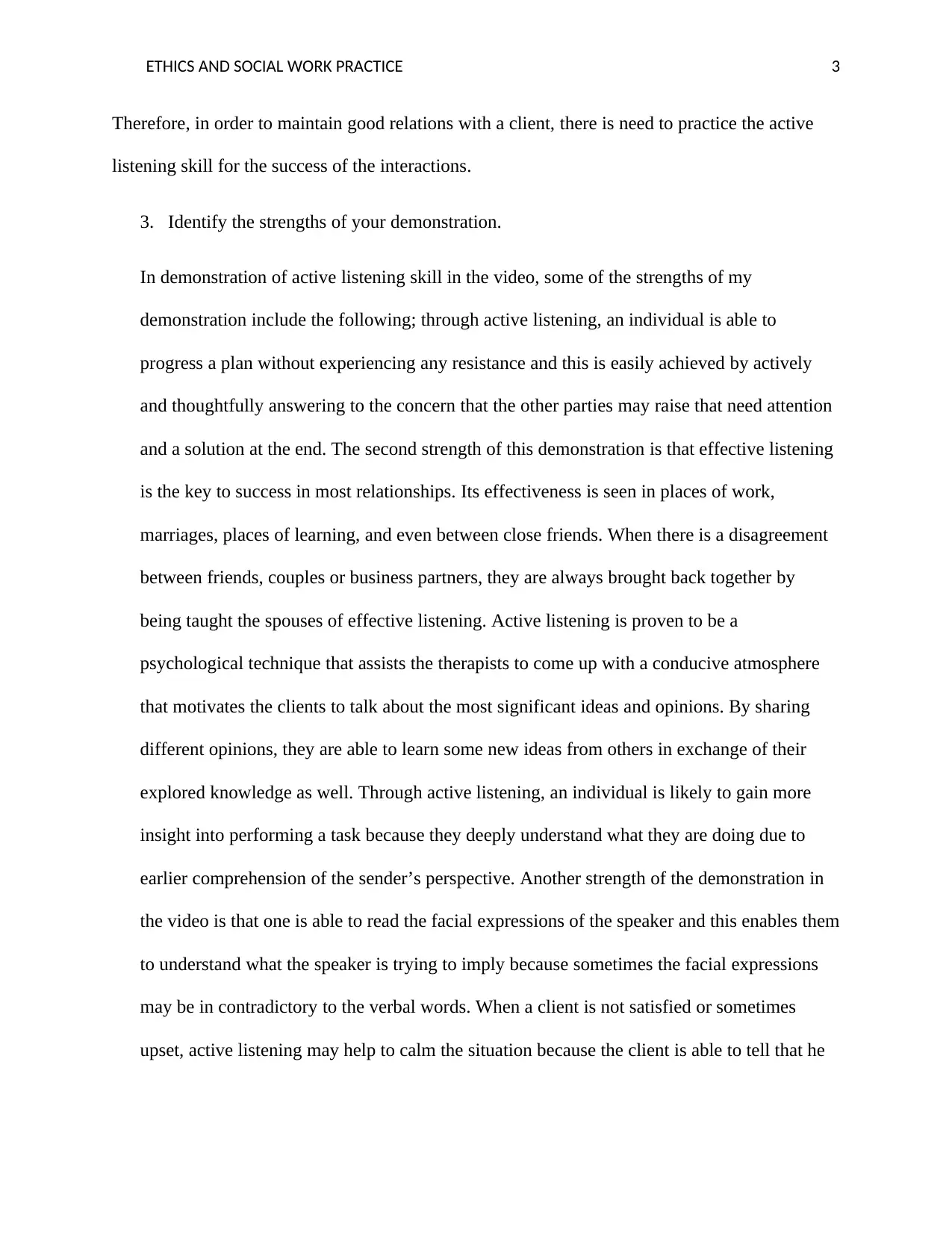
ETHICS AND SOCIAL WORK PRACTICE 3
Therefore, in order to maintain good relations with a client, there is need to practice the active
listening skill for the success of the interactions.
3. Identify the strengths of your demonstration.
In demonstration of active listening skill in the video, some of the strengths of my
demonstration include the following; through active listening, an individual is able to
progress a plan without experiencing any resistance and this is easily achieved by actively
and thoughtfully answering to the concern that the other parties may raise that need attention
and a solution at the end. The second strength of this demonstration is that effective listening
is the key to success in most relationships. Its effectiveness is seen in places of work,
marriages, places of learning, and even between close friends. When there is a disagreement
between friends, couples or business partners, they are always brought back together by
being taught the spouses of effective listening. Active listening is proven to be a
psychological technique that assists the therapists to come up with a conducive atmosphere
that motivates the clients to talk about the most significant ideas and opinions. By sharing
different opinions, they are able to learn some new ideas from others in exchange of their
explored knowledge as well. Through active listening, an individual is likely to gain more
insight into performing a task because they deeply understand what they are doing due to
earlier comprehension of the sender’s perspective. Another strength of the demonstration in
the video is that one is able to read the facial expressions of the speaker and this enables them
to understand what the speaker is trying to imply because sometimes the facial expressions
may be in contradictory to the verbal words. When a client is not satisfied or sometimes
upset, active listening may help to calm the situation because the client is able to tell that he
Therefore, in order to maintain good relations with a client, there is need to practice the active
listening skill for the success of the interactions.
3. Identify the strengths of your demonstration.
In demonstration of active listening skill in the video, some of the strengths of my
demonstration include the following; through active listening, an individual is able to
progress a plan without experiencing any resistance and this is easily achieved by actively
and thoughtfully answering to the concern that the other parties may raise that need attention
and a solution at the end. The second strength of this demonstration is that effective listening
is the key to success in most relationships. Its effectiveness is seen in places of work,
marriages, places of learning, and even between close friends. When there is a disagreement
between friends, couples or business partners, they are always brought back together by
being taught the spouses of effective listening. Active listening is proven to be a
psychological technique that assists the therapists to come up with a conducive atmosphere
that motivates the clients to talk about the most significant ideas and opinions. By sharing
different opinions, they are able to learn some new ideas from others in exchange of their
explored knowledge as well. Through active listening, an individual is likely to gain more
insight into performing a task because they deeply understand what they are doing due to
earlier comprehension of the sender’s perspective. Another strength of the demonstration in
the video is that one is able to read the facial expressions of the speaker and this enables them
to understand what the speaker is trying to imply because sometimes the facial expressions
may be in contradictory to the verbal words. When a client is not satisfied or sometimes
upset, active listening may help to calm the situation because the client is able to tell that he
⊘ This is a preview!⊘
Do you want full access?
Subscribe today to unlock all pages.

Trusted by 1+ million students worldwide
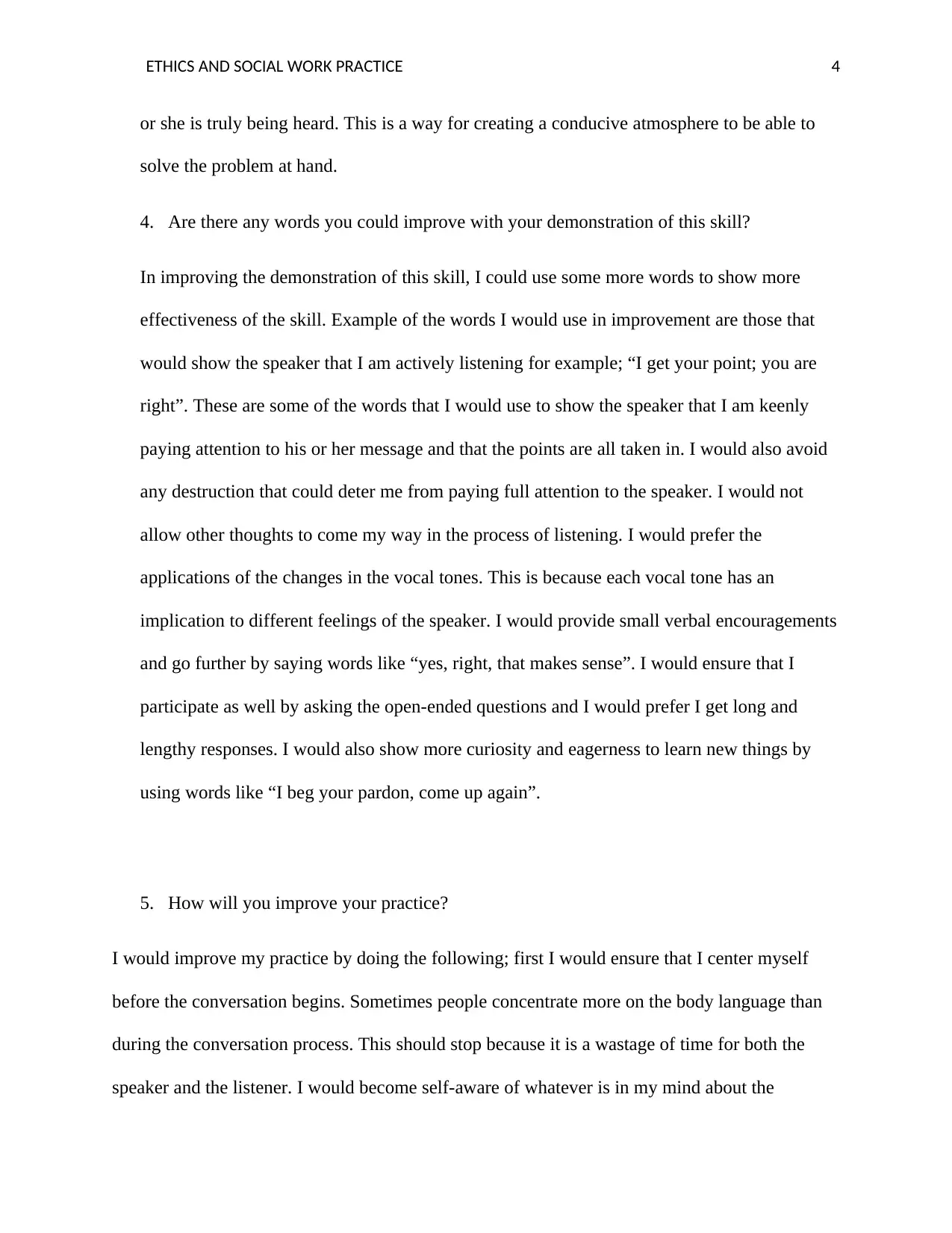
ETHICS AND SOCIAL WORK PRACTICE 4
or she is truly being heard. This is a way for creating a conducive atmosphere to be able to
solve the problem at hand.
4. Are there any words you could improve with your demonstration of this skill?
In improving the demonstration of this skill, I could use some more words to show more
effectiveness of the skill. Example of the words I would use in improvement are those that
would show the speaker that I am actively listening for example; “I get your point; you are
right”. These are some of the words that I would use to show the speaker that I am keenly
paying attention to his or her message and that the points are all taken in. I would also avoid
any destruction that could deter me from paying full attention to the speaker. I would not
allow other thoughts to come my way in the process of listening. I would prefer the
applications of the changes in the vocal tones. This is because each vocal tone has an
implication to different feelings of the speaker. I would provide small verbal encouragements
and go further by saying words like “yes, right, that makes sense”. I would ensure that I
participate as well by asking the open-ended questions and I would prefer I get long and
lengthy responses. I would also show more curiosity and eagerness to learn new things by
using words like “I beg your pardon, come up again”.
5. How will you improve your practice?
I would improve my practice by doing the following; first I would ensure that I center myself
before the conversation begins. Sometimes people concentrate more on the body language than
during the conversation process. This should stop because it is a wastage of time for both the
speaker and the listener. I would become self-aware of whatever is in my mind about the
or she is truly being heard. This is a way for creating a conducive atmosphere to be able to
solve the problem at hand.
4. Are there any words you could improve with your demonstration of this skill?
In improving the demonstration of this skill, I could use some more words to show more
effectiveness of the skill. Example of the words I would use in improvement are those that
would show the speaker that I am actively listening for example; “I get your point; you are
right”. These are some of the words that I would use to show the speaker that I am keenly
paying attention to his or her message and that the points are all taken in. I would also avoid
any destruction that could deter me from paying full attention to the speaker. I would not
allow other thoughts to come my way in the process of listening. I would prefer the
applications of the changes in the vocal tones. This is because each vocal tone has an
implication to different feelings of the speaker. I would provide small verbal encouragements
and go further by saying words like “yes, right, that makes sense”. I would ensure that I
participate as well by asking the open-ended questions and I would prefer I get long and
lengthy responses. I would also show more curiosity and eagerness to learn new things by
using words like “I beg your pardon, come up again”.
5. How will you improve your practice?
I would improve my practice by doing the following; first I would ensure that I center myself
before the conversation begins. Sometimes people concentrate more on the body language than
during the conversation process. This should stop because it is a wastage of time for both the
speaker and the listener. I would become self-aware of whatever is in my mind about the
Paraphrase This Document
Need a fresh take? Get an instant paraphrase of this document with our AI Paraphraser
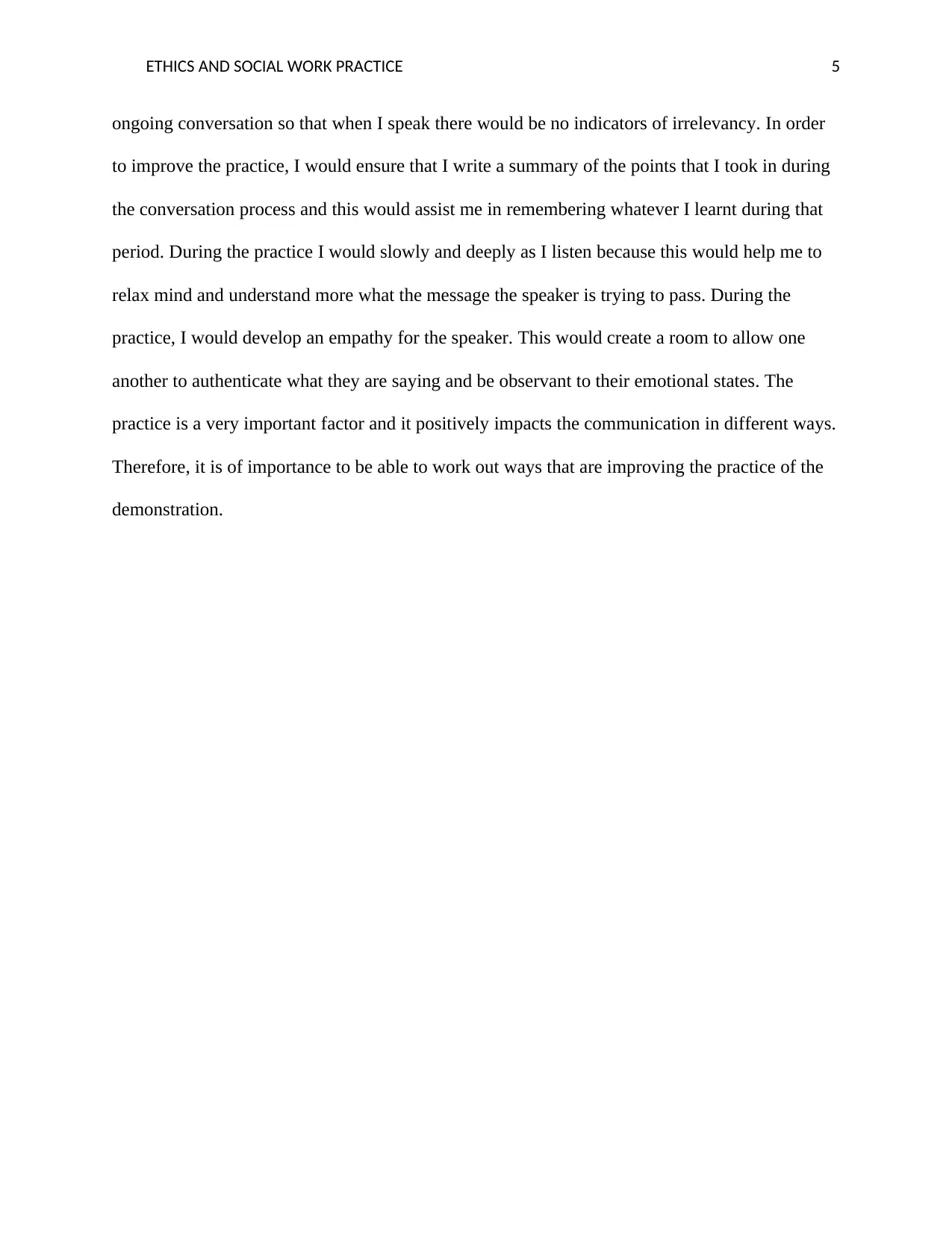
ETHICS AND SOCIAL WORK PRACTICE 5
ongoing conversation so that when I speak there would be no indicators of irrelevancy. In order
to improve the practice, I would ensure that I write a summary of the points that I took in during
the conversation process and this would assist me in remembering whatever I learnt during that
period. During the practice I would slowly and deeply as I listen because this would help me to
relax mind and understand more what the message the speaker is trying to pass. During the
practice, I would develop an empathy for the speaker. This would create a room to allow one
another to authenticate what they are saying and be observant to their emotional states. The
practice is a very important factor and it positively impacts the communication in different ways.
Therefore, it is of importance to be able to work out ways that are improving the practice of the
demonstration.
ongoing conversation so that when I speak there would be no indicators of irrelevancy. In order
to improve the practice, I would ensure that I write a summary of the points that I took in during
the conversation process and this would assist me in remembering whatever I learnt during that
period. During the practice I would slowly and deeply as I listen because this would help me to
relax mind and understand more what the message the speaker is trying to pass. During the
practice, I would develop an empathy for the speaker. This would create a room to allow one
another to authenticate what they are saying and be observant to their emotional states. The
practice is a very important factor and it positively impacts the communication in different ways.
Therefore, it is of importance to be able to work out ways that are improving the practice of the
demonstration.
1 out of 5
Related Documents
Your All-in-One AI-Powered Toolkit for Academic Success.
+13062052269
info@desklib.com
Available 24*7 on WhatsApp / Email
![[object Object]](/_next/static/media/star-bottom.7253800d.svg)
Unlock your academic potential
Copyright © 2020–2025 A2Z Services. All Rights Reserved. Developed and managed by ZUCOL.





